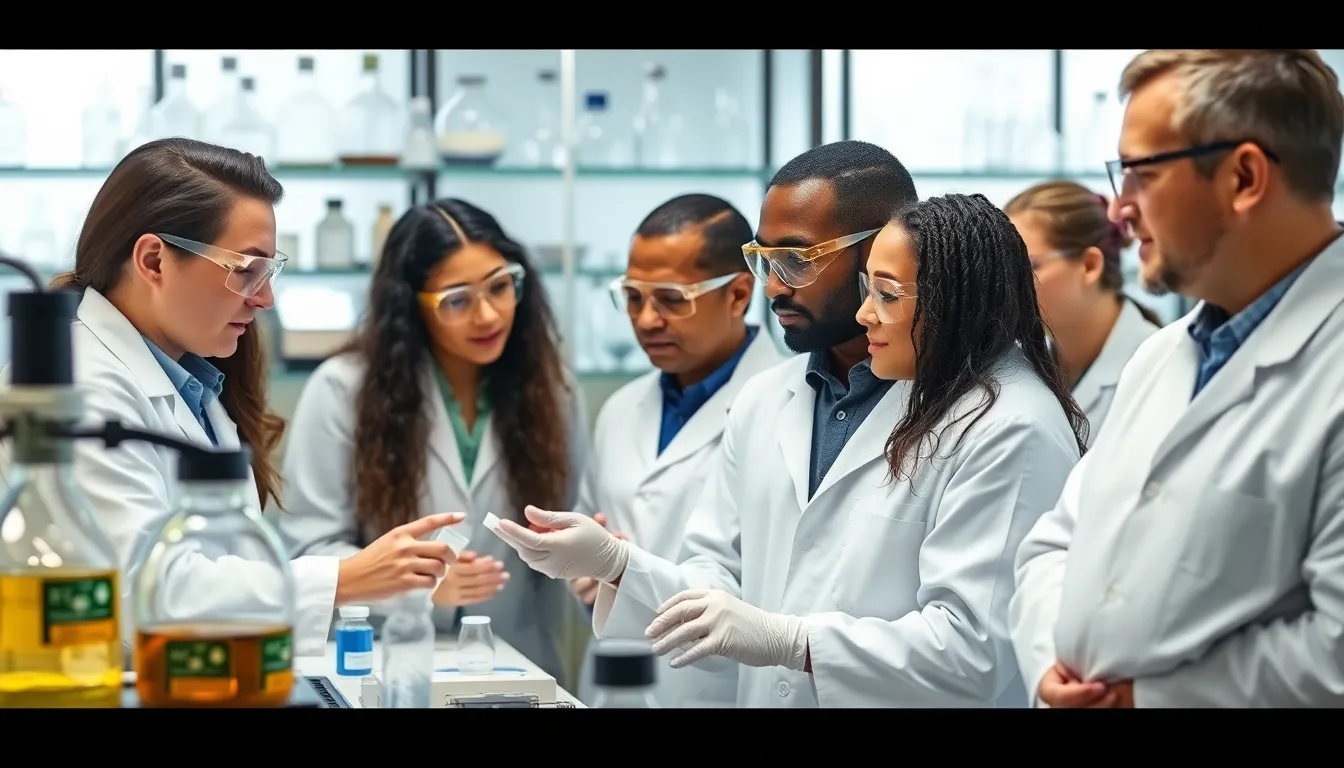In the fast-paced world of biotechnology, patents are the secret sauce that keeps innovation cooking. Imagine a lab full of scientists, bubbling beakers, and the next big breakthrough waiting to be unleashed. But without the protection of patents, those brilliant ideas could vanish faster than a donut at a morning meeting.
Table of Contents
ToggleOverview of Biotechnology Patents
Biotechnology patents serve a vital function in safeguarding innovations within the life sciences sector. They grant inventors exclusive rights to their inventions, preventing unauthorized use or reproduction by others. This exclusivity fosters an environment where researchers feel encouraged to invest time and resources into developing novel solutions.
Many aspects of biotechnology can be patented. These include biological materials, genetic sequences, methods for producing specific organisms, and biopharmaceuticals. Patent protection extends for up to 20 years, providing inventors a significant period to recoup investments and earn returns.
Patent applications must meet specific criteria. They must demonstrate novelty, non-obviousness, and utility. Novelty requires that the invention hasn’t been publicly disclosed previously. Non-obviousness entails that the invention isn’t an evident solution to someone skilled in the field. Lastly, utility confirms that the invention serves a functional purpose.
Obtaining a biotechnology patent involves a thorough process. Applicants typically submit a detailed description of the invention to the U.S. Patent and Trademark Office (USPTO). This process might take several years, during which patent examiners assess the validity of the application.
Challenges often arise during the patent examination process. Applicants may address technical complexities and legal interpretations regarding the scope of the patent claims. Views on what constitutes prior art can complicate matters, impacting claims of novelty and non-obviousness.
Despite these challenges, biotechnology patents significantly contribute to scientific progress. They support the financial ecosystem that fuels research and development. By protecting intellectual property, these patents ensure inventors can share their findings and innovations without the immediate threat of competition, leading to advancements in healthcare, agriculture, and environmental sustainability.
The Importance of Biotechnology Patents



Biotechnology patents play a crucial role in fostering innovation and protecting intellectual property in the life sciences. These patents give inventors exclusive rights, ensuring research is shielded from unauthorized use.
Protection of Innovation
Protection of innovation drives the biotechnology sector forward. Patents secure breakthroughs, providing researchers with the confidence to invest in novel ideas. Exclusive rights prevent competitors from replicating unique processes or products, preserving the commercial viability of inventions. This legal safeguard encourages collaboration among scientists, as teams work together without the fear of losing their valuable contributions. Additionally, patent protection acts as a strong incentive for companies to explore uncharted areas, such as developing new therapies or sustainable agricultural practices.
Economic Impact
Economic impact highlights the benefits biotechnology patents bring to the economy. The industry generates billions in revenue, significantly through biopharmaceuticals and agricultural innovations. Small startups often rely on patents to attract investors, demonstrating the potential return on investment. In 2021 alone, the global biotechnology market was valued at approximately $1.3 trillion and is projected to grow exponentially in the coming years. Job creation also stems from patent-protected innovations, as companies expand to meet demand and develop new solutions. Supporting research leads to advancements that improve health outcomes and enhance productivity across sectors.
Types of Biotechnology Patents
Biotechnology patents encompass various categories that protect different types of innovations in the field. These categories include utility patents, plant patents, and design patents, each serving a unique purpose.
Utility Patents
Utility patents cover new and useful inventions or discoveries. This category includes processes, machines, articles of manufacture, or compositions of matter. For instance, biopharmaceutical products such as vaccines and monoclonal antibodies often qualify for utility patents. Novel methods for producing genetically modified organisms also fit within this category. Utility patents provide protection for up to 20 years, depending on specific jurisdiction and application. During this period, inventors retain exclusive rights to exploit their inventions commercially.
Plant Patents
Plant patents focus specifically on new varieties of plants. These patents protect asexually reproduced plants, including hybrids and genetically altered strains. Examples include new types of crops, ornamental flowers, or fruit-bearing plants. Innovators must demonstrate distinctiveness, stability, and uniformity in the plants they seek to patent. Protection lasts for 20 years from the date of patent issuance, similar to utility patents. This exclusivity encourages agricultural research and development, contributing to enhanced food security and diversity.
Design Patents
Design patents protect the ornamental aspect of an invention. This protection applies to new, original, and non-obvious designs of articles of manufacture. In biotechnology, this might encompass unique packaging designs for biopharmaceuticals or distinctive laboratory equipment. The term of protection for design patents is 15 years if filed after May 13, 2015. Protecting design elements helps businesses differentiate their products in the marketplace, reinforcing brand identity and consumer recognition.
Challenges in Biotechnology Patents
Biotechnology patents face numerous challenges that can complicate the path to obtaining protection.
Ethical Considerations
Ethical concerns arise primarily from the implications of patenting living organisms. Many argue that granting patents on genetic materials might restrict access to essential resources, potentially hindering scientific research. The concept of commodifying life raises questions about the morality of ownership over genetic sequences and biological materials. Stakeholders in the biotechnology industry must navigate these moral dilemmas while striving for innovation. Balancing the rights of inventors with societal needs proves vital. Sensitivity toward these concerns is essential for fostering public trust and long-term advancements in biotechnology.
Legal Issues
Legal challenges often stem from the complexities of patent law as it applies to biotechnology. Navigating the nuances of patentability can lead to disputes regarding prior art and the scope of protection. Courts frequently interpret patent claims differently, resulting in inconsistent rulings. Such variability heightens the risk for companies when pursuing litigation or enforcing patent rights. Additionally, patent eligibility often depends on evolving judicial standards. Regulatory agencies enforce stringent requirements, potentially delaying the patent approval process. Stakeholders must remain cautious and informed about these changing legal landscapes to safeguard their innovations effectively.
Future Trends in Biotechnology Patents
Emerging technologies are reshaping the landscape of biotechnology patents. Innovations in gene editing, particularly CRISPR, are gaining attention, creating new opportunities for patenting unique sequences and methods. As these advancements proliferate, novel applications in agriculture and medicine are likely to present challenges and opportunities for patent protection.
Regenerative medicine is set to grow, leading to increased patent filings for stem cell therapies and tissue engineering. Companies specializing in these fields will utilize patents to secure funding and market their breakthroughs effectively. The focus on personalized medicine is also rising, emphasizing the need for patents on tailored therapies that target specific genetic profiles.
Investigations into artificial intelligence (AI) applications in biotechnology are gaining traction. AI-driven tools are enhancing research efficiency and innovation, leading to unique patentable inventions. As AI technology progresses, patent offices may need to adapt their evaluation criteria to accommodate these developments.
Environmental biotechnology is emerging as a key area for future patent activity. Solutions addressing climate change, such as biofuels and bioremediation methods, require patents to protect investments. Companies focusing on sustainability will play a crucial role in driving innovation while seeking robust patent portfolios.
Regulatory changes are anticipated, impacting biotechnology patents. Governments may introduce new policies to balance innovation with access to essential therapies. Stakeholders will need to navigate this evolving legal environment carefully, as it influences patent strategies across the biotechnology sector.
The future of biotechnology patents hinges on advancements in various fields, from gene editing to sustainability. Companies must stay informed about emerging trends and regulatory shifts to secure their intellectual property effectively.




